The following is a preliminary analysis of planning faculty listed in the Guide to Undergraduate and Graduate Education in Urban and Regional Planning (17th edition, dated 2011) published by the Association of Collegiate Schools of Planning. I queried Google Scholar for publication/citation data for each of the 850+ regular faculty listed in the guide (the primary tool used was Harzing’s Publish or Perish; see http://www.harzing.com/pop.htm). Because of name disambiguation, misspellings, etc., the resulting data from these searches required extensive cleaning to match authors with their publications. The original dataset consisted of over 62,000 records (publications indexed by Google Scholar [GS]) associated with approximately 975,000 citations. Automated and manual processes to clean the data for planning faculty reduced these numbers to 24,609 publications with 634,467 citations. This process is still underway, and I suspect the data are at least 85–90% clean at this point. Again, these data are preliminary but are reasonable estimates at this point. Following a brief discussion about academic citations are summary results from the initial analysis.
Citations
The traditional means of assessing academic productivity and reputation is citation analysis. Citation analysis for scholarly evaluation has an extensive literature that weighs appropriateness within and across disciplines as well as offering nuanced discussion of metrics (see, e.g., Adam, 2002; Garfield, 1972; Garfield & Merton, 1979; MacRoberts & MacRoberts, 1989, 1996; Moed, 2005). Recently, popular metrics like the h-index, g-index, and e-index have been adopted by GS to provide Web-based citation analysis previously limited to proprietary citation indexes like Thomson Reuters (formerly ISI) Web of Knowledge (WoK) and Sciverse Scopus. This is the likely trajectory of citation analysis as open access scholarship becomes more pervasive. There is some debate, however, that GS’s inclusion of gray literature citations means its analyses draw from a different universe of publications to assess citation frequency and lineage. Scholarly activity represents approximately one-third to one-half (or more) of faculty effort along with teaching and outreach/service activities. In many universities/disciplines, scholarly productivity and reputation are primary factors in deciding promotion and tenure cases.
Results
This initial analysis focused on the citation activity of planning faculty by (a) current school, (b) the school from which they received their PhD (or other terminal degree), (c) years as a professor (time since terminal degree was used as a proxy), (d) rank, and (e) individual faculty. The results are as of mid-November 2013 and will be continually refreshed with GS searches and manual data input and correction.
Table 1 list the top 25 planning schools based on the average number of GS citations per faculty member. Table 2 lists the top 25 in terms of citations per year of service (or year since degree) to account for faculty age or experience. On average, the work of the UCLA and USC planning faculty members has been cited over 3,000 times (averages are greatly influenced by particular faculty). In addition, planning faculty members at Penn, UCLA, ASU, Berkeley, SUNY Buffalo, and USC average over 100 citations per year.
Faculty Citations by School of Degree
The citation data can also be compared by the school where each faculty member received their terminal degree (usually a PhD). Table 3 shows the top 25 universities (not necessarily planning degrees) in terms of average total citation output. Table 4 shows citations per year of experience. Graduates from the University of Chicago and UCSB have the highest levels of citation activity among planning faculty. Of note is that UCSB does not have a planning program.
Although there is a significant amount of variation among individual planning faculty citations that effect department-level performance, there are distinct trends based on seniority. Figures 1 and 2 show both increasing mean and median citation totals by years of experience and rank. Currently, faculty with 5–6 years of experience (pre-tenure) average about 115 citations (median of 41), and those with 15–16 years of experience (around promotion to full professor) average over 500 citations (median of 300). However, these numbers do not control for types of institutions, teaching loads, and administrative activities. During the course of a career (30–50 years), faculty average between total 1,000 and 1,500 citations. In terms of those currently at the rank of assistant professor, the average is over 150, with associate professors averaging over 500 and full professors over 1,400.
Finally, there are many planning faculty with citation totals far exceeding the average levels discussed (the top 25 are shown in Table 5). All of the previous summary information for planning schools is based on GS citation totals for individual planning faculty. These totals will change over time as the data are corrected and updated as previously mentioned. The overall list of planning faculty is available here for download. Your help in updating these numbers will be greatly appreciated and will be used for an upcoming complete analysis. If your citations totals are very different from what is shown, please feel free to send me (tom.sanchez@vt.edu) your updated CV or links to your GS Citation profiles.
If you are interested in citation analysis and bibliometrics, you can visit my Mendeley Group at http://www.mendeley.com/groups/1318573/citation-analysis-bibliometrics-and-webometrics/ and my paper on the topic at http://papers.ssrn.com/sol3/papers.cfm?abstract_id=2157789.
References
Adam, D. (2002). Citation analysis: The counting house. Nature, 415(6873), 726–729.
Garfield, E. (1972). Citation analysis as a tool in journal evaluation. Science, 178(4060), 471–479.
Garfield, E. (1979). Citation indexing: Its theory and application in science, technology, and humanities. New York, NY: Wiley.
MacRoberts, M. H, & MacRoberts, B. R. (1989). Problems of citation analysis: A critical review. Journal of the American Society for Information Science, 40(5), 342–349.
MacRoberts, M. H, & MacRoberts, B. R . (1996). Problems of citation analysis. Scientometrics, 36(3), 435–444.
Moed, H. F. (2005). Citation analysis in research evaluation. Dordrecht, The Netherlands: Springer.


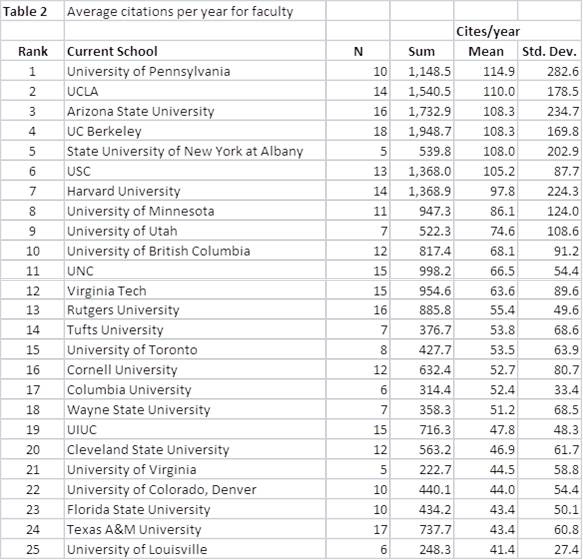
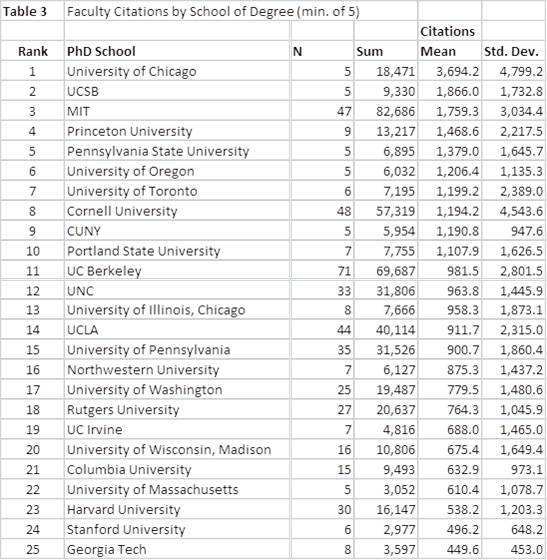
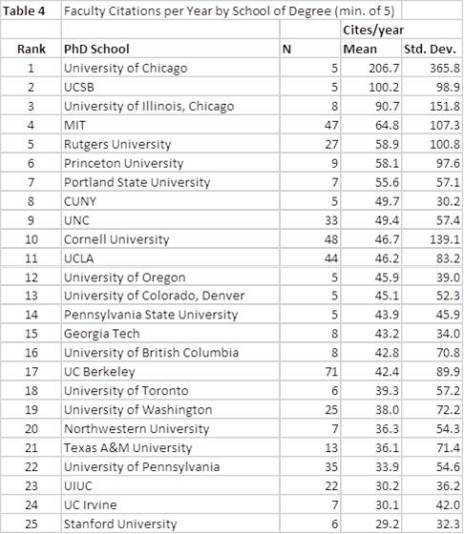
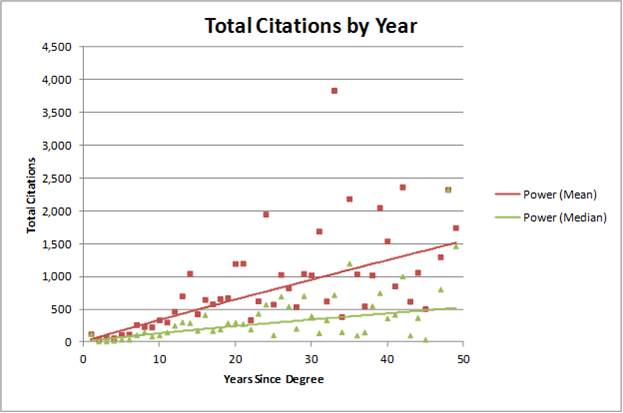
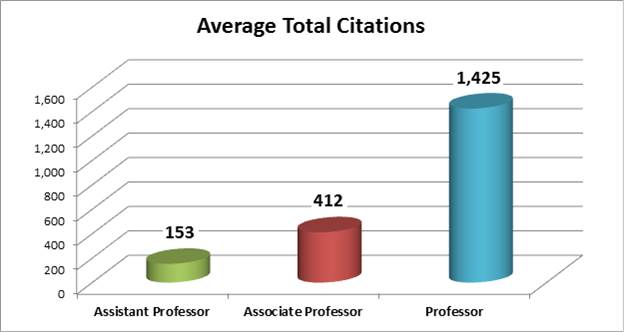
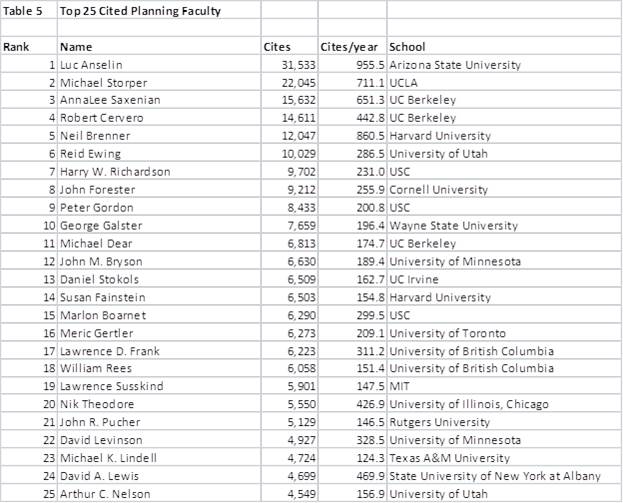
Pingback: Faculty Scholarly Productivity and Reputation in Planning: A Preliminary Citation Analysis | Transportationist
Pingback: CMP Department and Individual Faculty Noted for Publication Citations | CAP FACULTY BLOG
I missed Edward L Glaeser on that list. Nice post by the way!
I believe he is in an economics department and not planning.
Well I was delighted to see Tom Sanchez study https://tomsanchez.wordpress.com/2013/12/07/faculty-scholarly-productivity-and-reputation-in-planning-a-preliminary-citation-analysis/
of the best planning schools in North America (Canada nudged a few American schools out of the top 25) particularly since I graduated from the number two school (UCSB) and our relatively new planning program(University of Louisville) again finds itself ranked in the top 25 ahead of many other respected planning schools. I am sure that many people are scratching their heads and saying UCSB! Planning! They don’t even have a planning program there! Professor Sanchez rerun your data; there must be some kind of mistake. Yet, scholars who went to UCSB know that its the paradigm grounded in critical urban sociological analysis that produced this number two ranking. We learned planning via three programs: undergraduate Environmental Studies program, Geography, and Sociology. Plus Santa Barbara’s is considered by many one of the best American cities in terms of livability–earning high wages is not the sole reason for a city being great: bike ability, clean air, urban canopy, walkability also help.. I am proud to see that UCSB (where I got all my degrees–with occasional tutoring from UCB Michael Teitz and Dennis Keating) was ranked number 2 in terms of producing top planning scholars. With no formal planning program, what is the secret sauce at UCSB that has created so many important contributions in planning? We mostly came out of Sociology and Geography graduate programs. I was lucky to have gone there and studied Sociology with Harvey Molotch, Richard Appelbaum, Bill Bielby, Roger Friedland, Dick Flacks, with occasional visits from David Harvey, James O’Connor, Derek Shearer, Christopher Jenck’s, Dennis Keating, Bill Domhoff, Jurgen Habermas while I was there. I strongly believe that UCSB produces scholars with a unique planning perspective grounded in a critical sociological lense that looks at the needs of the powerless and poor and advocate for their cause. It also helped that our program at the time had two to three years of research methods and statistics led by such stat studs as Robert Smith, Bruce Straits, Bill Bielby and Richard “I can blow any study out of the water” Berk. I was deeply impacted by the hands- on-experience of seeing Harvey Molotch and Richard Appelbaum conduct an award winning planning study on growth impacts for medium size cities as an undergraduate in 1975-76. The study changed how the cities are planned and was a precursor of the environmental impact reports that are standard now. The impacts of growth also served as a foundation of Molotch’s, “The City as a Growth Machine,” I also salute UCSB Geography, which at the time was the floor above us, now edits a major planning journal and helped produce my favorite new urbanist planner Emily Talen now at MIT. Moreover, UCSB has also produced, Susan Anderson, the Director of Planning for Portland, Oregon. While scholars on this list serve beat their chests claiming tow schools of thought exist: Chicago and LA school–is LA REALLY the future of American cities. Santa Barbara produced another model that medium size works great. I really think UCSB produced a unique kind of green urbanism / new urbanism school. I think the beauty and lifestyle of Santa Barbara shapes your thinking about green urbanism: live small, walk/bike as much as you can and live in dense neighborhoods. Much of what we see being introduced in cities today was there forty years ago with bike paths, community gardens, co-ops, green business enterprises, health food, vegetarian restaurants, pocket parks and stewardship of the earth started in Santa Barbara. In fact, Harvey Moloch argues that the “hinge” of the environmental movement started in 1969 with the Santa Barbara Oil Spill. Molotch also states that UCSB Sociology founded “Environmental Sociology.” I was also glad to see that my tiny Planning program of six faculty at the University of Louisville is ranked in the top 25 by two different measures in terms of citations. We also got ranked in the top 25 by reputational analysis by ACSP planning group. We are very proud of that since the only other programs at UofL ranked in the top 25 are baskeball and football. So thanks for the study and I hope my explanation explains how UCSB got ranked number 2 in producing the best urban planning scholars. Perhaps planning departments should rethink recruiting policies where they invite applicants only from planning schools and be more open to those who are trained in Sociology we obviously have something to say. When you consider the real giants in planning (International Poll) had many of them are trained in sociology like Herbert Gans, Harvey Molotch, Richard Appelbaum, Gregory Squires, and Richard Florida and Sharon Zukin. Moreover the two highest rated books in planning Jane Jacobs (Death and Life of Great American Cities) and Duany / Plater-Zyberk /Speck *Suburban Natio” sue old school sociological analysis. So all we are saying is give sociology a little bit more respect planners.
Dr. Gilderbloom,
Not to take anything away from MIT, but Emily Talen is on the faculty at Arizona State (though she is a visiting professor in Boston this academic year, which is probably what you meant). As a two-time Sun Devil, including a master’s in planning, I want to make sure my alma mater gets recognized for academics as well as sunshine, parties, and an especially attractive student body.
The flaws of using Google Scholar are well documented in Science Magazine (see http://www.sciencemag.org/content/342/6163/1169.2.full.pdf?sid=1d030109-0838-4767-9af6-3e90e4b693ec and http://www.sciencemag.org/content/343/6166/14.full.pdf?sid=1d030109-0838-4767-9af6-3e90e4b693ec). Bonhannon (2014) states in the second of these articles “because it includes sources from across the Internet not only vetted journals and has no human curators, Google Scholars citation metric can be easily gamed.” While the broad coverage can be an advantage in a profession like planning where faculty publish policy-based research reports, Google Scholar also is inconsistent in how it lists multiple documents. If we are going to go down this road, we should at least be more honest about the limitations of the methodology.
Pingback: Faculty Scholarly Productivity and Reputation in Planning | College of Architecture + Planning